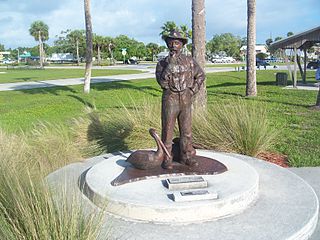
Jefferson Davis Parish is a parish located in the U.S. state of Louisiana. As of the 2010 census, the population was 31,594. The parish seat is Jennings. Jefferson Davis Parish is named after the president of the Confederacy during the American Civil War, Jefferson Davis. It is located in southwestern Louisiana and forms a part of the Acadiana region.

Intracoastal City is an unincorporated community in Vermilion Parish, Louisiana, United States. It is situated on the west bank of the Vermilion River at its junction with the Gulf Intracoastal Waterway and has various port facilities and some permanent residents.

The Tensas River National Wildlife Refuge is a protected wildlife area located west of the city of Tallulah in Madison, Tensas and Franklin parishes in northeastern Louisiana, USA.

Sabine National Wildlife Refuge is a National Wildlife Refuge of the United States located in Cameron Parish in southwestern Louisiana. It is on Louisiana State Route 27, 8 miles (13 km) south of Hackberry and 12 miles (19 km) north of Holly Beach. The western boundary of the Sabine Refuge is Sabine Lake, the inlet for Port Arthur, Texas, while the tip of the eastern end reaches Calcasieu Lake.

The question of whether to drill for oil in the Arctic National Wildlife Refuge (ANWR) has been an ongoing political controversy in the United States since 1977. As of 2017, Republicans have attempted to allow drilling in ANWR almost fifty times, finally being successful with the passage of the Tax Cuts and Jobs Act of 2017.

Cokeville Meadows National Wildlife Refuge is a National Wildlife Refuge of the United States located in Wyoming. It is managed by the U.S. Fish and Wildlife Service, an agency within the U.S. Department of the Interior.

Marsh Island is an island off the coast of southern Louisiana in the United States.

The Massachusetts Audubon Society, founded in 1896 by Harriet Hemenway and Minna B. Hall, headquartered in Lincoln, Massachusetts, is a nonprofit organization dedicated to "protecting the nature of Massachusetts". Mass Audubon is independent of the National Audubon Society, and was founded earlier. Mass Audubon protects 36,500 acres of land throughout Massachusetts, saving birds and other wildlife, and making nature accessible to all with its wildlife sanctuaries and 20 nature centers.

The Connecticut Audubon Society Birdcraft Museum and Sanctuary, also known as Birdcraft Museum & Sanctuary or simply Birdcraft Sanctuary, in Fairfield, Connecticut is the oldest private songbird sanctuary in the United States. It was established in 1914 by Mabel Osgood Wright.

Bayou Teche National Wildlife Refuge is located in the coastal towns of Franklin, Garden City and Centerville on Bayou Teche in Louisiana, USA. The 9,028-acre (36.54 km2) refuge is forested with bottomland hardwoods and cypress-gum forests. The refuge was established in St. Mary Parish in 2001. The surrounding area includes oil and gas wells and canals.

Handy Brake National Wildlife Refuge is located just north of Bastrop, Louisiana in Morehouse Parish, north central Louisiana. The refuge was established in 1988 with the southeast's first fee title transfer of a Farmer's Home Administration tract to the U.S. Fish and Wildlife Service. A free lease of 38 acres (150,000 m2) from International Paper increased the refuge to the current 501 acres (2.03 km2).

The Audubon Society of Portland is a non-profit environmental organization dedicated to wildlife conservancy in Portland, Oregon, United States.

Paul James Rainey was an American businessman, philanthropist, hunter, and photographer.

Crooked Tree Wild Life Sanctuary (CTWS) is a protected area in Belize. It is recognized as a Wetland of International Importance. It was designated as a waterfowl habitat on April 22, 1998 under the Ramsar Convention on Wetlands. During Belize’s dry season many resident and migratory birds find refuge in the lagoons. The sanctuary contains 16,400 acres of lagoons, creeks, log wood swamps, broad leaf forest and pine savanna, home to hundreds of species of wildlife. The Sanctuary protects globally endangered species including the Central American River Turtle, Mexican Black Howler Monkey, and Yellow-headed Parrot.

The Connecticut Audubon Society, founded in 1898 and headquartered in Fairfield, Connecticut, is a nonprofit organization dedicated to "conserving Connecticut’s environment through science-based education and advocacy focused on the state’s bird populations and habitats." Connecticut Audubon Society is independent of the National Audubon Society.

Plume hunting is the hunting of wild birds to harvest their feathers, especially the more decorative plumes which were sold for use as ornamentation, such as aigrettes in millinery. The movement against the plume trade in the United Kingdom was led by Etta Lemon and other women and led to the establishment of the Royal Society for the Protection of Birds. The plume trade was at its height in the late 19th and was brought to an end in the early 20th century.

The Margery Adams Wildlife Sanctuary, usually called the Adams Wildlife Sanctuary, is a 40-acre (0.16 km2) headquarters building and land parcel owned and managed by the Illinois Audubon Society. Its second-growth forest land and restored tallgrass prairie are managed so as to maximize the diversity of the urban wildlife that visits the property. It is named after Margery Adams who donated the property to the society.

Paul Kroegel was a German immigrant to the United States who helped establish Pelican Island as a bird sanctuary in Florida. Kroegel is listed as a Great Floridian.

White Lake Wetlands Conservation Area (WLWCA), officially the White Lake Property, is a 71,905 acre tract of protected area located 7.4 miles (11.9 km) south of Gueydan at the south end of Louisiana Highway 91 in Vermilion Parish, Louisiana.















